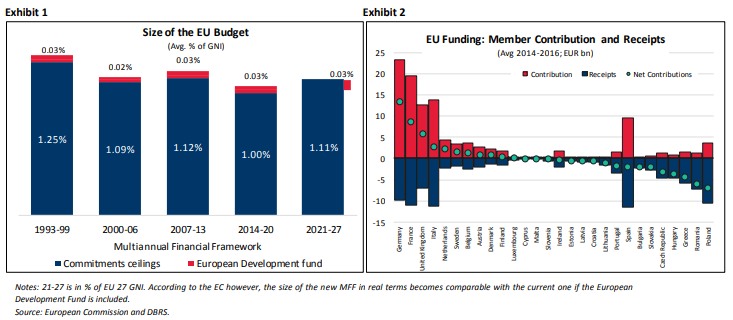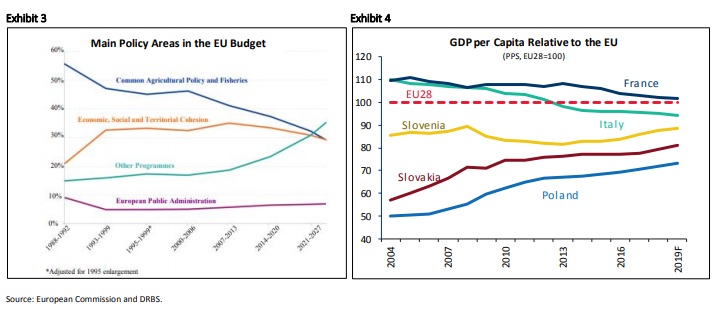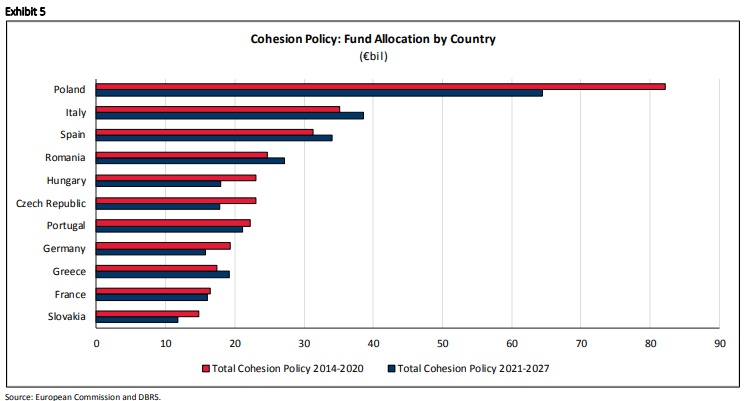Analytics, Budget, EU – Baltic States, Financial Services, Markets and Companies
International Internet Magazine. Baltic States news & analytics
Saturday, 20.04.2024, 07:19
EU Budget – what about Eastern Europe?
 Print version
Print versionThe budget
requires unanimous agreement at the European Council and the consent of the
European Parliament. Funding implications will likely be felt in 2023. In
DBRS’s view, if the UK does not contribute to some of the EU programmes and/or
pays a fee as a non-member like Norway after Brexit, the EU may need to make up
around EUR 10 billion per year (including rebates), based on the current
contributions to the MFF. The proposal outlines a set of key issues including:
higher contributions from the remaining 27 members following the UK departure
from the union; incremental spending on new priorities such as border control,
security and defense; and a reduction in funds to the Cohesion Policy (CP) and
the Common Agriculture Policy (CAP). DBRS notes that East European members that
have relied significantly on the EU budget to sustain their development might
see development funds fall from the current range of 2%-5% of their respective
GDPs. This is due to (1) a proposed 5% cut in the CP and CAP funding, (2)
proposed strengthening in the link between EU funding and the rule of law, and
(3) an increase in national co-financing.
EU Budget:
A Test of Unity The EC proposal aims to revise the structure, the size, and the
content of the EU budget to better reflect the political ambitions that the EU
has set for its future. The draft poses a test of unity among members,
especially between net contributors and net recipients. The draft’s spending
shift towards new challenges such as defense, migration, security, and climate
change is to be balanced with a moderate cut in the CP and CAP. The 2014-2020
MFF amounts to EUR 1,087 billion in current prices, or 1.03 percent of the
bloc’s gross national income (GNI). The EC draft for the next MFF points to a
rise to around EUR 1,279 billion, equal to 1.11% of GNI (Exhibit 1). This
implies a significant increase in the burden of the budget considering the
impact of the UK’s departure from the bloc, which will leave the EU budget
without the third-largest net contributor (Exhibit 2).

Revenues:
The EU's current revenue sources primarily include contributions from member
countries (75%), VAT based contributions (13%), and tariffs/duties levied on
goods entering the EU (11%). The 2021-2027 MFF proposes simplifying the current
VAT system. New sources of revenue making up around 12% of the EU budget are
likely to come from emission trading systems, a share of a new Common
Consolidated Corporate Tax Base, and a new non-recycled plastic packaging waste
tax. The MFF also proposes abolishing ‘rebates and corrections’. Rebates were
put in place to refund states that bear a disproportionate cost of EU spending.
However, despite a gradual phase-out in the first five years, those members
that have been benefiting from the rebate are expected to oppose the change
during the negotiations. These include Germany, Sweden, Austria, and Denmark.
In addition, the EC draft proposes a reduction from 20% to 10% in the share
that members can retain for collecting revenues generated from custom duties.
Expenditures: Agriculture and regional cohesion policy currently account for
nearly 70% of the budget. The first draft of the 2021-2027 MFF proposes a
reduction of 5% to CAP and CP funds to facilitate increased spending on
migration, innovation, security, and other global projects. The EC also plans
to set up a EUR 25 billion Reform Support, basically “money for reforms”, for
financial and technical support to those countries pursuing reform programmes
in the context of the European Semester. In addition, the EC plans to use a
European Investment Stabilization Function to support investment in the event
of large systemic shock with resources up to EUR 30 billion.

The
Cohesion Policy, accounting for 33% of the current budget, plays an important
role in supporting the on-going economic reforms of the Member States. In
addition to the proposed 5% cut in CP and CAP funding, the 2021-2027 MFF has
also proposed changes to the allocation of such funds. While relative GDP per
capita is likely to remain the predominant criteria for allocating funds, the
draft proposal places greater weight on indicators such as demographics, youth
employment, climate change and the reception and integration of migrants. In
addition to strengthening the link between EU funds and the rule of law, the EC
intends to impose a modest degree of conditionality without relieving the
member states of their EU budget obligations. Funds disbursement could be
suspended or reduced in case of deficiencies relating to the rule of law.
However, this could be only vetoed by a qualified majority of the European
Council (55% of the member states, representing 65% of the population), in contrast
to the current system which requires unanimous vote of all the member states.
The reduction in spending in agriculture and cohesion funds, coupled with the proposal to link EU funding to the rule of law, is likely to generate opposition by those countries that have received the highest share of the funds. As seen in Exhibit 5, Poland is the largest beneficiary of the Cohesion Policy and is expected to receive up to EUR 86 billion until 2020. This represents around 3% of Poland’s GDP annually and 56% of public investment. Access to funding, among other factors, has facilitated Poland’s integration into Western Europe, supporting the rise in Poland’s GDP per capita on a PPP basis to 69% of the EU average, up from 49% in 2004.

*The
Cohesion policy is the EU’s main investment policy that provides the necessary
investment framework to reduce disparities between EU regions. It is delivered
through European Regional Development Fund (ERDF), the Cohesion Fund (CF), the
European Social Fund (ESF). European Electoral Campaign May Pave the Way for
More Complex Negotiations In DBRS’s view, negotiations over the budget are
likely to be difficult. They are being carried out in a different context from
the previous MFF, when the Eurozone was strained by the sovereign crisis. It
took almost two years to agree on the EUR 1 trillion for the 2014-2020 MFF.
This time debates might occur during the electoral campaign for the European
election scheduled in May in 2019. This environment could cause delays and
intensify the complexity of the negotiations, which might be concluded by a new
European Parliament and Commission in 2020. Should an agreement not be reached,
2020 MFF ceilings and provisions will be extended until a new MFF is adopted.








 «The Baltic Course» Is Sold and Stays in Business!
«The Baltic Course» Is Sold and Stays in Business!

